MacMuser
iDisk Ennui
At last! The weather in England has shaken off winter’s gloom, and spring has started for real. The longer days and shorter evenings mean that we can sit in the garden watching the sun disappear into the horizon rather than behind rain clouds.
It was such an warm evening recently that found me sitting in the evening sun, listening to bell-ringers practice in the distant church tower while I nursed a glass of chilled English bacchus wine from my local vineyard. So few of my fellow countrymen know we produce superb wines and some that beat even the best in the world. After all, we share the same soil and climate as the Champagne region of France, and the Romans knew a thing or two when they planted vines here a couple of thousand years ago. It was a Dutchman and German I met at a party who told me about English wine. A quick scan of Yellow Pages proved I am surrounded by vineyards, all of which have to be visited…regularly. In the name of research, naturally.
As I sat sipping, the bush next to me was humming to itself. It isn’t much of a plant, comfrey, a Russian infiltrator that grows wild. But bees love comfrey, and it was these causing the humming. Most jars of honey name the type of plants the bees have fed on, but I have never seen one advertising it was from comfrey. Maybe they have it in the Ukraine? Comfrey flowers don’t share the same intense smell one associates with Australian leatherwood honey or Mexican orange blossom, but obviously bees can find some attraction.

Humming Bush
Unfortunately, the bees also describe how I feel about Apple’s .Mac service—“hmmmmmm, where’s the attraction?.”
I let Apple’s previous attempts at presenting an online experience—AppleLink and eWorld—pass me by. Apple had originally used AppleLink as a support service for dealers and developers, but it was expensive to run. They decided to expand it to consumers, to switch suppliers, and lower running costs. The new AppleLink Personal Edition, started in 1987, was supplied by Quantum Computer Services who renamed in 1991 to America Online. Apple licensed the original AppleLink software and changed its name to eWorld.
Apple introduced eWorld in 1994 and for two years supplied e-mail, news, and a bulletin board system in return for large amounts of their clients’ wealth. eWorld never took off, probably because Apple kept it proprietary and closed to the burgeoning Windows community. Plus, it was in direct competition with America Online, who supplied eWorld.
eWorld had been devised in the days when the only Web browser available was Tim Berners-Lee’s imaginatively named WorldWideWeb. Tim wrote this for NEXTSTEP, which a decade later became Mac OS X. Where, in 1991, no-one had a Web site other than the boffins at CERN, by 1993 other browsers such as NCSA/Mosaic had been devised by clever people who were to go on to found Netscape, among others. The new cross-platform browsers took off and left online communities such as eWorld behind.
Apple’s latest online offering grew from iTools, originally a free part of Mac OS 9 and the new Mac OS X. Included were HomePage, a free Web hosting service; iDisk online storage; mac.com, a free e-mail service; and iCards, free greetings cards.
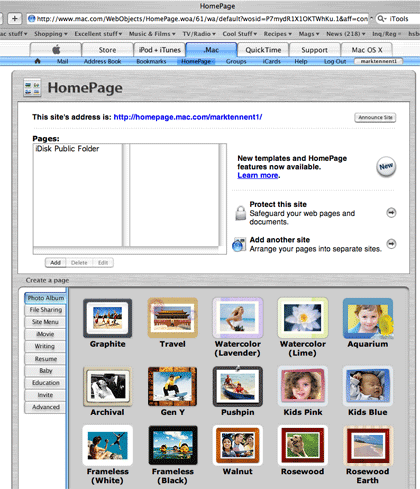
HomePage
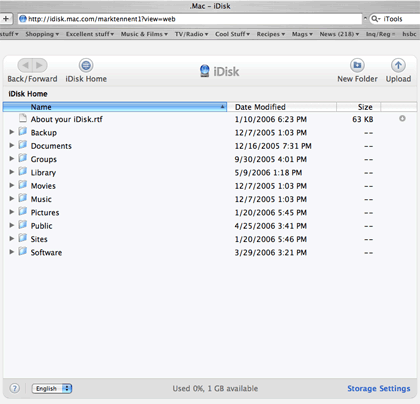
iDisk

mac.com Mail
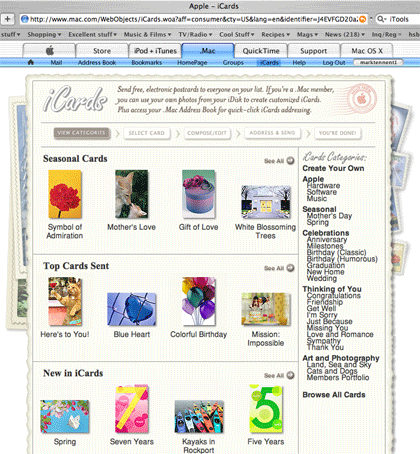
iCards
To get around disk storage limitations, users created two or more accounts. Recognising a revenue-earner when they saw one, in 2002 Apple renamed iTools to .Mac in parody of Microsoft’s .Net service, and started to charge for it. To sweeten the blow to users, Apple threw in free software including McAfee’s Virex virus scanner. I was an early adopter of OS X and iTools but decided to pass on the paid-for version, only to change my mind a little later, resulting in the numeral 1 being added to my old mac.com e-mail address.
In the four years since then, .Mac has changed a little and not all for the better. Account holders no longer get a copy of Virex, for example. Nowadays the iDisk limit is 1 GB with more available at extra cost, and mac.com e-mail has a few more tricks up its sleeve. HomePage, the free Web site host and generator, has also gained some features, including more templates, and Groups—a way to create your own online community to share information, calendars, announcements and files. These online tools are tightly integrated with Apple’s free desktop software including iPhoto, Backup, and iSync.
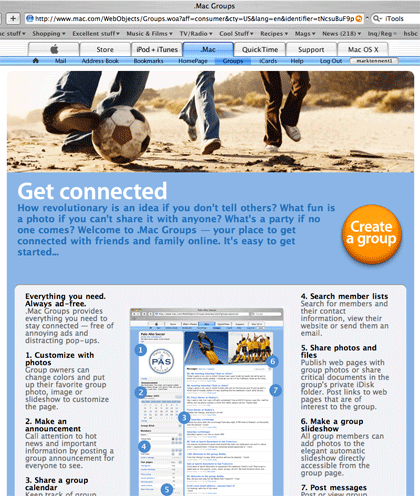
Groups
.Mac is based on the WebDav and IMAP protocols. The former is an extension for HTTP, the hypertext transfer protocol the Internet uses to share information and publish Web pages. The latter is one of the standard ways to exchange e-mail messages across the Internet. Together they make .Mac available to any computer able to access the Internet, and one would think they would work reliably and efficiently. Not so in my experience.
The main reason I have kept my .Mac subscription, apart from stopping my namesakes from grabbing my name, is so I can upload large files. My son lives in Chicago, I have friends around the world, and we like to swap photographs, movies, and so on. As a designer, I need to make huge files available to printers, repro-houses, and other professionals. So an iDisk with a gigabyte of storage space seems ideal. It means we should not need to connect computer-to-computer to exchange files, especially when our local time zones may be 12 hours apart.
I have never been able to upload a file of more than a few tens of megabytes to my iDisk. Everything seems to be working correctly, and then the lights on my ADSL-router stop blinking. On screen, the little beachball is still spinning but nothing happens. I’ve even left things like that for hours before canceling the whole transfer. Usually this leaves an incomplete file that until recently I had to send a begging e-mail to the Apple technicians asking them to delete it for me. There is a free WebDAV application called Goliath that should be more reliable at sending files to iDisk but it suffers the same fate—terminal ennui. At least Goliath lets me delete the failures, but I cannot recommend it after suffering more than a crash or two.
To send files of up to 100 MB and more there are various free services such as Dropload and SendThisFile (also search Google for “related: www.dropload.com”). They all work in a similar way—you send the file to them via a Web browser, and they send an e-mail to the intended recipients with a link to download the file. In my experience these free services are one hundred percent better than iDisk because they actually achieve the transfer, where iDisk has refused to accept the file in the first place.

Dropload
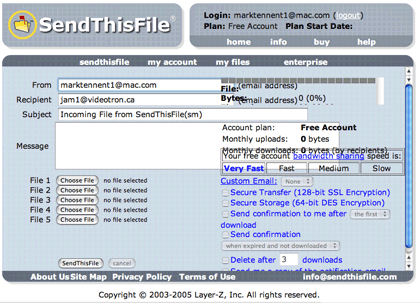
SendThisFile
The remaining parts of .Mac work reasonably well. There have been times when I made simple Web sites as a fast and dirty way to get information across, using the templates Apple provide for HomePage. As the site is generated, HomePage is able to automatically announce the location by sending an eCard to the people you want to know about it. Often the link on the eCard refuses to work for some unknown reason. The site is exactly where the link says it is, but it only generates an error message.
On the other hand, HomePage and its close integration with iPhoto enabled me to take on a builder with whom I was in dispute. I simply took photos of the bad materials and workmanship the builder expected me to pay for, let iPhoto generate the Web site for me, and announced it to his e-mail address. No matter that all the Web site’s hits measured by the on-screen counter were actually generated by my friends and family. When the builder saw a Web site saying “Look at what this cowboy did to my house” with indisputable photos, he immediately caved in.
Nowadays, there are many alternatives to the tools offered by .Mac and as easily integrated with the other Mac applications such as iPhoto. RapidWeaver, for example, can create and upload photo slide shows, movies, and file transfer sites as easily as HomePage. Backup and syncing software, another part of the .Mac experience, is freely available, such as LaCie’s SilverKeeper. ClamXav is a free anti-virus application. As for the remainder of .Mac, it seems over-priced and for a UK user. It may be that distance is the cause of file transfers not working or that lengthy transfers get “forgotten” by .Mac and are left to fester incomplete.
For no-brainer, point-and-click Web site creation, e-mail and file storage, .Mac could be the answer for you, but I’m less than happy with it and wonder whether to keep my subscription.
Hmmmmmm.
Also in This Series
- What Trick, What Device, What Starting-Hole… · May 2012
- Do Androids Dream? · April 2012
- Our Macs Are Under Attack · March 2012
- The Best and Worst Christmas Presents · February 2012
- The Best Use for a Kindle · January 2012
- It’s Got No Blinking Light · January 2012
- Box-Shifting Causes Migration · December 2011
- The Best Thing About the iPhone 4S and How to Cope in Clink · December 2011
- Death of a Salesman · November 2011
- Complete Archive
Reader Comments (4)
Thank you for a lovely commentary.
(I even read the part about .Mac!)
I am a London-born Merseysider who has lived in California for many years. The ground is moving beneath my feet as this country seems to be changing for the worse--or I am just getting old.
To read of you sitting in your garden, listening to the distant bells, was too piquant for words.
I am a semi-retired pastor, and use .Mac and iWeb for a church website. I could not have created a site except for the ease-of-use of .Mac and iWeb.
The church pays for .Mac, and I save a little by buying our subscription for Amazon. I sincerely doubt I would buy .Mac for my own use.
I do think the URLs on .Mac are clumsy and long; and people tell me the site loads slowly.
Thank you again for a most pleasant page (blog). Please keep it up.
Regards,
Roy Gee
Thank you for your fine comments. They were well received.
I can assure you I really was sitting in the garden listening to the bell ringers and the bees humming. It was a quintessentially English experience. As was the wine but that is another thing altogether.
Today I got an iCard from a Danish friend with links to iWeb photos of her rapidly growing family. She is just sharing her life with her contacts around the world and it made me realise that there is a great value in the facilities offered by .Mac if one chooses to use them. Maybe I've been a little too cynical about .Mac?
I'm just off back to my garden to watch tiny pipistrelle bats flit across the pond and fly between my wife and I us as we talk. They fly so close and so fast it is magic.
Or maybe it's the glass of wine I will be drinking… :-)
http://www.yellowmug.com/filechute/
Add A Comment